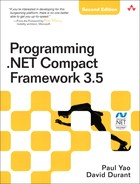Book Description
"If you're interested in developing for this burgeoning platform, there is no one better able to get you up-to-speed.”
–From the Foreword by Rob Tiffany, mobility architect, Microsoft
Completely revised and updated for .NET Compact Framework 2.0 and 3.5, Visual Studio 2008, and Windows Mobile Smart Phones, Programming .NET Compact Framework 3.5, Second Edition, teaches you how to write highly effective applications for handheld wireless devices with small screens, limited memory, and finite battery life.
This book is the definitive tutorial and reference for the .NET Compact Framework and Windows Mobile. If you’re interested in developing for this burgeoning platform, there is no one better able to get you up to speed than industry veterans, master programmers, and teachers Paul Yao and David Durant.
With this book you will learn how to
Use each of the ten API sets available for Windows Mobile; when to use each; and, especially, when to use Win32 and the .NET Compact Framework 2.0 and 3.5
Write programs that make the most of a Windows Mobile device’s limited battery life
Efficiently invoke Win32 APIs from the .NET Compact Framework
Write exceptional, data-driven applications using data binding and .NET controls
Manage device data with the object store, file I/O, and the registry
Work with databases using ADO.NET and LINQ
Synchronize mobile data with remote databases and the remote API
Make a mobile device work with the Windows Communication Foundation (WCF)
Create graphical output on Windows Mobile devices
If you want to learn Windows Mobile development but only have limited experience with the .NET Framework, this is the only book you need.
Table of Contents
- Copyright
- Praise for Programming .NET Compact Framework 3.5, Second Edition
- Figures
- Tables
- Foreword
- Preface
- Acknowledgments
- About the Authors
- 1. Mobile Phone Programming
- 1.1. Selecting an Application Programming Interface
- 1.2. Memory Management
- 1.3. Conclusion
- 2. Extending Battery Life
- 3. Platform Invoke
- 3.1. Overview of P/Invoke
- 3.2. Creating P/Invoke Declarations
- 3.3. Supported P/Invoke Function Parameters
- 3.4. A Sample Program: CallWin32
- 3.5. Writing Win32 Dynamic Link Libraries
- 3.6. Manual P/Invoke Parameter Passing
- 3.7. Communicating between Native and Managed Code
- 3.8. Comparing P/Invoke Support
- 3.9. Conclusion
- 4. Data Binding to Controls
- 4.1. Data Binding
- 4.2. Complex Data Binding
- 4.3. Simple Data Binding
- 4.4. The DataGrid Control
- 4.4.1. Using Complex Data Binding with the DataGrid Control
- 4.4.2. Styling the Display of Data in a DataGrid Control
- 4.4.3. Creating Table and Column Styles
- 4.4.4. Creating Styles at Runtime
- 4.4.5. Responding to User Input
- 4.4.6. Using Simple Data Binding with the DataGrid Control
- 4.4.7. Accessing DataGrid Information
- 4.4.8. Providing Drill-Down Capability
- 4.4.9. Providing In-Place Editing Capability
- 4.4.10. Providing Automated In-Place Editing Capability
- 4.5. Conclusion
- 5. Storage
- 5.1. Smart-Device Data Storage
- 5.2. File I/O
- 5.2.1. The File and Directory Classes
- 5.2.2. Byte-Level I/O
- 5.2.3. Higher-Level I/O
- 5.2.4. Encoding and Decoding Data
- 5.2.5. Using the I/O Classes
- 5.2.6. Text File I/O
- 5.2.7. Binary File I/O
- 5.2.8. Writing Binary Data
- 5.2.9. Reading Binary Data
- 5.2.10. Binary I/O and Structures
- 5.2.11. XML File I/O
- 5.2.12. Easier XML Serialization
- 5.3. Registry Access
- 5.4. Conclusion
- 6. ADO.NET Programming
- 6.1. Examining ADO.NET
- 6.2. Working with Data Sets
- 6.3. Microsoft SQL Server CE
- 6.3.1. SQL Server CE Files
- 6.3.2. SQL Server CE Syntax
- 6.3.3. SQL Server CE Query Analyzer
- 6.3.4. Creating a SQL Server CE Database
- 6.3.5. Populating a SQL Server CE Database
- 6.3.6. Retrieving and Displaying Data
- 6.3.7. Updating a SQL Server CE Database
- 6.3.8. The SqlCeDataAdapter Class
- 6.3.9. Querying Schema Information
- 6.4. Microsoft SQL Server
- 6.5. Web Services
- 6.6. Conclusion
- 7. LINQ
- 8. Synchronizing Mobile Data
- 8.1. Understanding SQL Server CE Synchronization
- 8.2. Installing Remote Data Connectivity
- 8.3. Using RDA
- 8.4. Using Merge Replication
- 8.5. Choosing between Merge Replication and RDA
- 8.6. Using Data Synchronization Services
- 8.7. Conclusion
- 9. The Remote API
- 10. Windows Communication Foundation
- 11. Creating Graphical Output
- 11.1. An Introduction to .NET Compact Framework Graphics
- 11.2. Drawing on the Display Screen
- 11.3. Raster Graphics
- 11.4. Vector Graphics
- 11.5. Conclusion
- 12. Text and Fonts
- A. Hungarian Notation for .NET Programs
- B. Windows API Allocation and Cleanup Functions
